Queensbury Tunnel: Cycle way campaigners offer tunnel vision
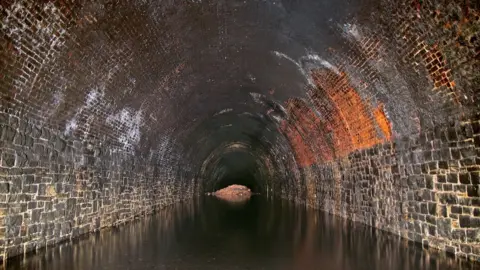 Forgotten Relics
Forgotten RelicsHundreds of feet below the Pennine hills between Bradford and Halifax is the most controversial infrastructure project you've probably never heard of.
It's 1.4 miles (2.3km) long and at least 10 people died building it in the Victorian era.
Queensbury Tunnel has been slumbering, forgotten and deserted for decades.
Yet it could be resurrected as a shining example of an integrated, green transport network. Or it could be about to be blocked up and forgotten forever.
Although, thanks to a recent series of unfortunate events, it's anyone's guess as to what happens next.
Deep in a green urban valley on the outskirts of Bradford, Graham Bickerdike watches contractors coming and going from the north portal of the tunnel.
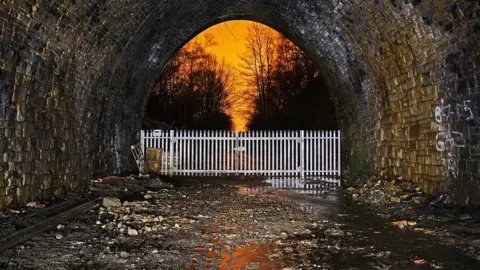 Forgotten Relics
Forgotten RelicsMr Bickerdike is the engineering co-ordinator for the campaign to turn the old track-bed into a cycle way, which would be sure to attract people from miles around.
"Unfortunately, Highways England (which is responsible for the tunnel) neglected to pay the £50 annual rent on the pumping station at the south end which keeps it dewatered," he said.
"As a result of that, in the following few months, 8.2 million gallons of floodwater entered the tunnel.
"Highways England described it as a 'simple but unfortunate administrative error'. But there's now 37ft of water at that end."
'£2m error'
There's so much water that, when it flooded, the southern end disappeared and is marked by a new inland lake which now has fish in it. When I visited a year ago you could see the light at the other end of the tunnel but that is now submersed and invisible.
Highways England has said it never received a demand for rent for the pump, nor did the owner, which is the Department for Transport.
Official documents suggest it should have been paid whether formally demanded or not.
That water now needs pumping out.
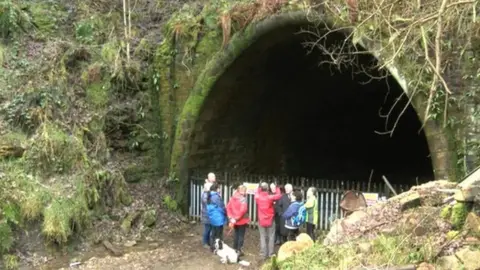
Mr Bickerdike suggests that "simple but unfortunate administrative error" could cost the taxpayer £2m.
Highways England admits the water problem has pushed up costs but certainly not by that much.
It also means contractors working on site can only do so from the dry northern end. To get to the other end they have had to make safe the central part of the tunnel, which was always regarded as the most dangerous section.
By doing so, campaigners believe, the tunnel is being made usable by default and it would be madness to abandon it.
"The work they've now carried out in the worst part of the tunnel, in the middle, to put in steel strengthening, actually forms the basis of a permanent repair," said Mr Bickerdike.
"That has likely reduced the cost of repair, so we are now at a point where the cost of abandonment and the cost of repair have practically converged."
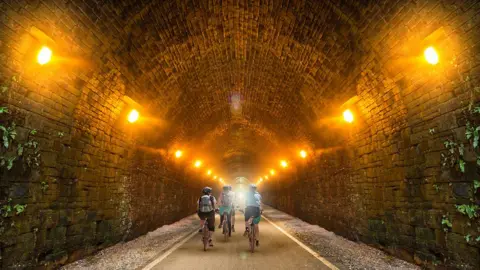 Four by Three
Four by ThreeIf you currently look into the northern end of the tunnel you can see workers and a ventilation system noisily working. If this was turned into a cycling tunnel it would join up the Bradford and Halifax districts.
You could cycle easily between the two, doing away with a grinding hill climb to get there.
Railway tunnels have been converted successfully elsewhere and it is easy to imagine people travelling from afar to cycle through this historic railway link.
It is a long tunnel and the costs going forward would be substantial but supporters argue the money users would generate would make it viable in the long-term.
Watching on, Nora McWilliam is at the forefront of the campaign to get a cycleway built.
A retired teacher, her home is on a hilltop overlooking the valley. I ask her if she thinks there would be such a prolonged debate if the tunnel ran under the hills of Surrey?
"No, I don't," she laughs.
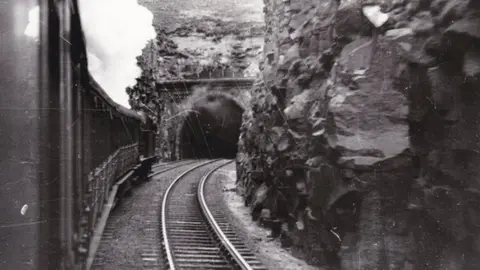 H C Casserley
H C CasserleyThe frustration is being felt politically too. The Queensbury Tunnel campaign is now being backed by both Bradford and Calderdale councils, which each have one end of the tunnel. But those local authorities admit they do not have the money to make it happen.
The issue has made it to Parliament where a cross-party alliance of local MPs wants to see it transformed rather than forgotten. The Labour MP for Halifax, Holly Lynch is one of them.
"It's just something that could really add to our transport infrastructure. Let's get it open, get it renovated and get people using it," she said.
"When you consider it's going to cost more than £5m just to fill it in with concrete, that money is there for filling it in, but why can we not convert that into money for repurposing it, making it something majestic?"
Pressure is now being put on ministers to rethink the current direction of travel towards abandonment.
It's a railway tunnel at a flooded crossroads.
